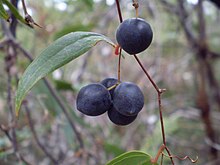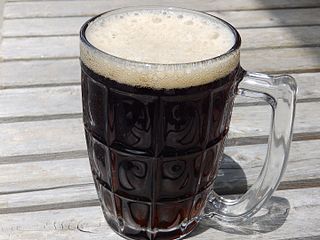
Root beer is a sweet North American soft drink traditionally made using the root bark of the sassafras tree Sassafras albidum or the vine of Smilax ornata as the primary flavor. Root beer is typically, but not exclusively, non-alcoholic, caffeine-free, sweet, and carbonated. Like cola, it usually has a thick and foamy head. A common use is to add vanilla ice cream to make a root beer float.
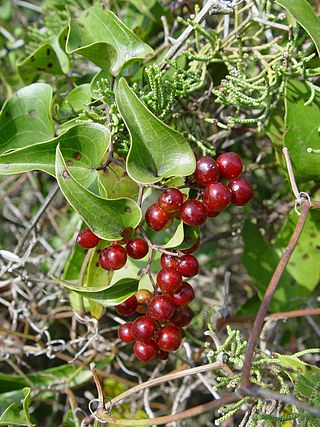
Smilax is a genus of about 300–350 species, found in the tropics and subtropics worldwide. They are climbing flowering plants, many of which are woody and/or thorny, in the monocotyledon family Smilacaceae, native throughout the tropical and subtropical regions of the world. Common names include catbriers, greenbriers, prickly-ivys and smilaxes. Sarsaparilla is a name used specifically for the Neotropical S. ornata as well as a catch-all term in particular for American species. Occasionally, the non-woody species such as the smooth herbaceous greenbrier are separated as genus Nemexia; they are commonly known by the rather ambiguous name carrion flowers.

Bearberries are three species of dwarf shrubs in the genus Arctostaphylos. Unlike the other species of Arctostaphylos, they are adapted to Arctic and subarctic climates, and have a circumpolar distribution in northern North America, Asia and Europe.

Smilax ornata is a perennial trailing vine with prickly stems that is native to Mexico and Central America. Common names include sarsaparilla, Honduran sarsaparilla, and Jamaican sarsaparilla.

Amaranthus viridis is a cosmopolitan species in the botanical family Amaranthaceae and is commonly known as slender amaranth or green amaranth.
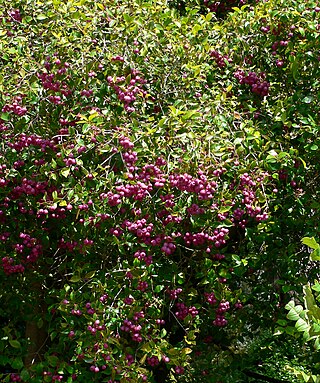
Syzygium smithii is a summer-flowering, winter-fruiting evergreen tree, native to Australia and belonging to the myrtle family Myrtaceae. It shares the common name "lilly pilly" with several other plants.It is planted as shrubs or hedgerows, and features: rough, woody bark; cream and green smooth, waxy leaves; flushes of pink new growth; and white to maroon edible berries. Unpruned, it will grow about 3–5 m (9.8–16.4 ft) tall in the garden.
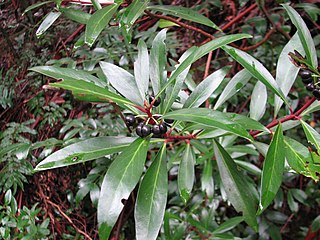
Tasmannia lanceolata, commonly known as Tasmanian pepperberry or mountain pepper, is a shrub native to woodlands and cool temperate rainforest of south-eastern Australia. The shrub varies from 2–10 metres (6.6–32.8 ft) high. The aromatic leaves are lanceolate to narrow-elliptic or oblanceolate, 4–12 cm long, and 0.7–2.0 cm wide, with a distinctly pale undersurface. Stems are quite red in colour. The small cream or white flowers appear in summer and are followed by black, globose, two-lobed berries 5–8 mm wide, which appear in autumn. There are separate male and female plants.

Eucalyptus oil is the generic name for distilled oil from the leaf of Eucalyptus, a genus of the plant family Myrtaceae native to Australia and cultivated worldwide. Eucalyptus oil has a history of wide application, as a pharmaceutical, antiseptic, repellent, flavouring, fragrance and industrial uses. The leaves of selected Eucalyptus species are steam distilled to extract eucalyptus oil.

Aralia nudicaulis is a flowering plant of northern and eastern North America which reaches a height of 30–60 cm (12–24 in) with creeping underground stems.

Carissa spinarum, the conkerberry or bush plum, is a large shrub of the dogbane family (Apocynaceae), widely distributed in tropical regions of Africa, Southern Asia, Australia, and various islands of the Indian Ocean. It is most well known in Australia, where it is also called currant bush or, more ambiguously, native currant or even black currant. It is, however, neither closely related to plums (Prunus) nor to true currants (Ribes), which belong to entirely different lineages of eudicots. In India, it is also called wild karanda /wild karavanda, referring to the related karanda. Carissa spinarum is often discussed under its many obsolete synonyms.
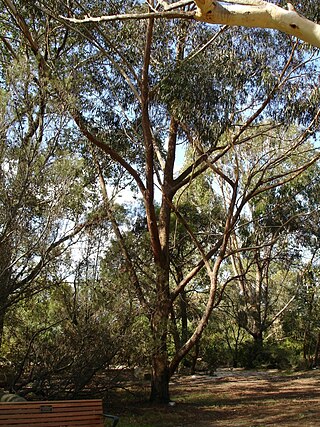
Eucalyptus piperita, commonly known as Sydney peppermint and urn-fruited peppermint, is a small to medium forest tree native to New South Wales, Australia.

Austromyrtus dulcis is a species of plant native to eastern Australia. it grows as a small spreading shrub and is easily recognised by its characteristic berries that usually ripen in summer and autumn. Common names include the midgen berry, midyim, and silky myrtle.

Eustrephus is a monotypic genus in the family Asparagaceae, subfamily Lomandroideae.

Boscia senegalensis, commonly known as hanza, is a member of the family Capparaceae.
Dennis Considen was an Irish-born surgeon, best known for his pioneering role in the use of Australian native plants for pharmaceutical use, especially eucalyptus oil, which he used to treat the convicts. He sailed with the First Fleet as surgeon on the Scarborough, which transported English convicts to Port Jackson, Australia, in 1788.

Smilax glauca, the cat greenbriar or catbriar is a woody vine in the family Smilacaceae. It is native to central and eastern portions of the United States as well as Mexico, where it is a common and conspicuous part of the forest vegetation.

Diospyros australis is the most southerly of the group of some 450 ebonies and persimmons. It is a shrub or small tree growing in rainforests of seaward eastern Australia. The habitat is in a variety of different rainforest forms, though not often seen in the cool temperate rainforests. The range of natural distribution is from Durras Lake near Batemans Bay in south east New South Wales, to Atherton in tropical Queensland.
Sarsaparilla often refers to the sarsaparilla soft drink, made from Smilax plants.

Sarsaparilla is a soft drink originally made from the vine Smilax ornata or other species of Smilax such as Smilax officinalis. In most Southeast Asian countries, it is known by the common name sarsi, and the trademarks Sarsi and Sarsae. It is similar in flavor to root beer. In the US, sarsaparilla is traditionally made with birch oil rather than the tropical plant.

Smilax aristolochiifolia, also known as gray sarsaparilla, Mexican sarsaparilla, sarsaparilla, is a species in the genus Smilax and the family Smilacaceae, native to Mexico and Central America. It is widely used as traditional medicine to treat many symptoms.
